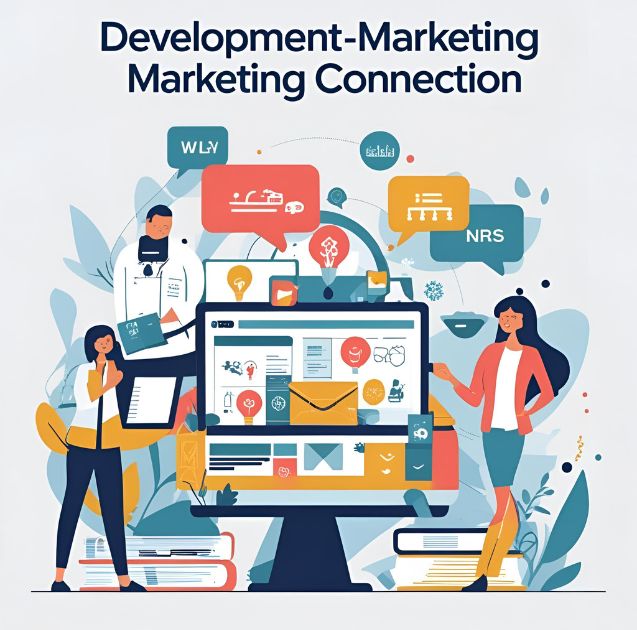Most marketers focus on subject lines, personalization, and content when optimizing their email campaigns. But there’s a crucial element that often gets overlooked: web development.
The technical foundation of your email marketing infrastructure plays a massive role in determining whether your campaigns succeed or fail. From deliverability rates to user experience, the way your emails are coded, hosted, and integrated with your website can make or break your marketing efforts.
This post explores the critical connections between web development and email marketing success, revealing how technical decisions directly impact your campaign performance and bottom line.
The Technical Foundation of Email Marketing

Email marketing isn’t just about writing compelling copy and designing beautiful templates. Behind every successful campaign lies a complex web of technical components that must work seamlessly together.
Web development encompasses the server configurations, database management, API integrations, and coding practices that power your email marketing platform. These technical elements determine how quickly your emails are sent, whether they reach the inbox, and how they display across different devices and email clients.
Consider this: your email service provider relies on web servers to process and deliver thousands of emails per minute. The quality of these servers, their geographic distribution, and how they’re configured directly affect your delivery speed and reputation with internet service providers.
Server Infrastructure and Email Deliverability
Your email deliverability hinges largely on the server infrastructure supporting your campaigns. Poor server management can land your emails in spam folders, regardless of how engaging your content might be.
IP Reputation Management
Email service providers track the reputation of IP addresses used to send emails. When multiple clients share the same server infrastructure, one sender’s poor practices can affect everyone else’s deliverability rates.
Quality web development ensures proper IP warming procedures, dedicated IP allocation for high-volume senders, and continuous monitoring of sender reputation scores. These technical safeguards protect your ability to reach customers’ inboxes consistently.
Authentication Protocols
Modern email deliverability requires several authentication protocols working in harmony. SPF (Sender Policy Framework), DKIM (DomainKeys Identified Mail), and DMARC (Domain-based Message Authentication) records must be properly configured at the DNS level.
Web developers handle these configurations, ensuring your domain is authenticated and trusted by major email providers like Gmail, Outlook, and Apple Mail. Without proper authentication, even legitimate marketing emails face higher chances of being filtered as spam.
Responsive Design and Cross-Client Compatibility
Email clients display HTML differently than web browsers, creating unique challenges that require specialized web development skills.
HTML and CSS Limitations
Unlike modern web development, email HTML must accommodate older rendering engines and limited CSS support. Web developers must understand these constraints to create emails that display consistently across Gmail, Outlook, Apple Mail, and dozens of other email clients.
This means using table-based layouts instead of modern CSS Grid, inline styles instead of external stylesheets, and extensive testing across multiple platforms. Poor email coding can result in broken layouts, missing images, or unreadable text on certain devices.
Mobile Optimization
Over 60% of emails are opened on mobile devices, making responsive design crucial for email marketing success. Web developers must implement media queries and flexible layouts that adapt to various screen sizes while maintaining readability and functionality.
Mobile-optimized emails see significantly higher click-through rates and conversions compared to emails that don’t display properly on smartphones and tablets.
Database Integration and Personalization
Effective email marketing relies on seamless integration between your email platform and customer databases. Web development creates the APIs and data pipelines that make advanced personalization possible.
Real-Time Data Synchronization
Modern email marketing platforms need access to up-to-date customer information, purchase history, and behavioral data. Web developers build the integration layers that sync this information in real-time, enabling triggered campaigns based on user actions.
For example, abandoned cart emails require immediate synchronization between your e-commerce platform and email system. The technical implementation of these integrations determines how quickly these time-sensitive messages can be deployed.
Dynamic Content Generation
Personalized product recommendations, location-based offers, and individualized content blocks all require sophisticated backend development. APIs must query customer databases, process the information, and generate personalized content elements before each email is sent.
The efficiency of these systems directly impacts both the relevance of your email content and the speed of campaign deployment.
Website-Email Integration Points
Your website and email marketing efforts shouldn’t exist in isolation. Strategic web development creates multiple touchpoints that amplify your email marketing effectiveness.
Subscription Forms and Lead Capture
The technical implementation of email subscription forms affects both user experience and data quality. Proper form validation, progressive profiling capabilities, and smooth integration with your email platform determine how effectively you can grow your subscriber list.
Advanced implementations include exit-intent popups, scroll-triggered subscription offers, and multi-step lead magnets that require careful coordination between web development and email marketing systems.
Landing Page Optimization
Email campaigns often drive traffic to dedicated landing pages. The loading speed, mobile responsiveness, and conversion optimization of these pages directly impact your email marketing ROI.
Web developers ensure these landing pages load quickly, display correctly across devices, and include proper tracking codes to measure the effectiveness of your email campaigns.
Performance Monitoring and Analytics
Data-driven email marketing requires sophisticated tracking and analytics capabilities that depend on proper web development implementation.
Tracking and Attribution
Understanding which emails drive conversions requires complex tracking systems that follow users from email click to final purchase. Web developers implement UTM parameters, conversion pixels, and cross-domain tracking to provide accurate attribution data.
This tracking infrastructure helps marketers understand the true ROI of their email campaigns and optimize future sends based on performance data.
A/B Testing Infrastructure
Systematic email testing requires backend systems that can randomly segment audiences, deploy different email versions, and track performance metrics. The technical implementation of these testing frameworks determines how quickly you can optimize your campaigns.
Security and Compliance Considerations
Email marketing involves handling sensitive customer data and must comply with regulations like GDPR, CAN-SPAM, and CCPA. Web development plays a crucial role in maintaining compliance and security.
Data Protection Measures
Proper encryption, secure API endpoints, and access controls protect customer information throughout the email marketing process. Web developers implement these security measures to prevent data breaches and maintain customer trust.
Compliance Automation
Automated unsubscribe processing, data retention policies, and consent management systems require careful development to ensure ongoing compliance with privacy regulations.
Optimizing the Development-Marketing Connection

Success requires close collaboration between web development and marketing teams. Here are key strategies for maximizing this partnership:
Establish Clear Communication Channels: Regular meetings between development and marketing teams ensure technical capabilities align with campaign goals.
Implement Staging Environments: Test all email campaigns in development environments before deploying to avoid technical issues that could damage sender reputation.
Monitor Performance Metrics: Track both technical metrics (delivery rates, loading times) and marketing metrics (open rates, conversions) to identify optimization opportunities.
Plan for Scalability: Design systems that can handle growing subscriber lists and increasing campaign complexity without performance degradation.
Building Your Email Marketing Foundation
The intersection of web development and email marketing creates opportunities for significant competitive advantages. Companies that invest in robust technical infrastructure see higher deliverability rates, better user experiences, and improved campaign performance.
Start by auditing your current technical setup. Are your authentication protocols properly configured? Do your emails display consistently across all major email clients? Is your subscriber data syncing accurately with your email platform?
Consider partnering with developers who understand email marketing requirements, or invest in training your existing team on email-specific development challenges. The technical foundation you build today will determine your email marketing success for years to come.







